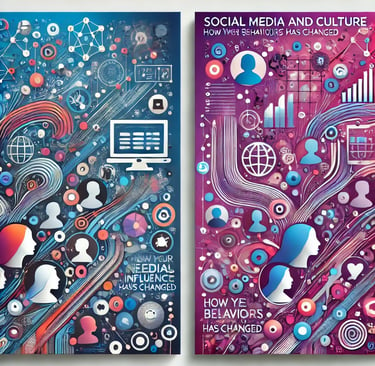Social Media and Culture: How Our Behaviors Have Changed
DIGITAL CULTURE AND PHILOSOPHY


Social Media and Culture: How Our Behaviors Have Changed
The advent of social media has profoundly transformed the way we communicate and interact. Today, we can instantly share moments of our lives with friends and strangers across the globe. This has fostered a culture of hyper‑connectivity: we constantly update ourselves on birthdays, news, daily memes, and participate in global conversations via hashtags and trends. On one hand, this makes the world feel smaller and more interconnected—as seen with movements like #MeToo or #BlackLivesMatter that unite voices around common causes. On the other hand, there are side effects, such as constant social comparison. On social media, we tend to showcase only our best moments (happy photos, successes), which can create the misleading impression that everyone else’s life is perfect—potentially leading to feelings of inadequacy or FOMO (fear of missing out).
An evident cultural impact is the evolution of language and expression. The widespread use of emojis, acronyms (like LOL, IMHO), and concise communication styles is reshaping everyday interactions. Social media has also given rise to new narrative formats: think of Instagram Stories, which disappear after 24 hours, or the short, viral videos on TikTok—new communication “dialects” especially mastered by younger generations. There is also a shift in identity formation: online, people can craft a kind of “personal brand” by curating what they post. This raises questions about authenticity versus performance in our interactions.
Social media has also blurred the boundary between public and private. Intimate moments—such as a family lunch—can become content to share publicly. New etiquette is emerging: what is appropriate to post? Can you tag someone in a photo without their consent? We are gradually learning digital norms. Moreover, constant virtual interaction sometimes comes at the expense of face‑to‑face contact: many find texting easier than making a phone call or speaking in person. While social media satisfies our need for connection, it does not replace real human interaction—and indeed, there is a growing appreciation for offline experiences (like device‑free dinners or board game nights) as a counterbalance.
A critical cultural aspect is information dissemination. Today, news and opinions often circulate on social media even before traditional media report them. While this democratizes information—allowing anyone to report an event—it also opens the door to misinformation and filter bubbles. Many of us tend to follow pages and people who echo our views, creating “echo chambers” where our opinions go unchallenged. This polarization can hinder constructive dialogue and is a stark reminder of how easily public opinion can be manipulated online.
In summary, while social media offers enormous opportunities—self‑expression, connection, and knowledge—it has also changed our behaviors, from the pursuit of likes to the habit of endless scrolling. Like every cultural shift, we are still adapting our norms and habits. The hope is to strike a balance where social media remains a positive tool without dominating our social lives, leaving room for analog interactions and the value of slowing down and reflecting in our fast‑paced digital world.
Bibliography:
WHO – “Teens, screens and mental health” (2024).
Harvard Misinformation Review – “Fake news e social media” (2020).
Pew Research – “Social Media & News” (2021).
Common Sense Media – “Social Media, Social Life” (2018).